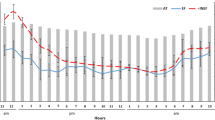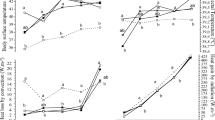Abstract
Notwithstanding the solar radiation is recognized as a detrimental factor to the thermal balance and responses of animals on the range in tropical conditions, studies on the amount of thermal radiation absorbed by goats therein associated with data on their production and heat exchange are still lacking. Metabolic heat production and the heat exchange of goats in the sun and in the shade were measured simultaneously, aiming to observe its thermal equilibrium. The results showed that black goats absorb twice as much as the white goats under intense solar radiation (higher than 800 W m−2). This observation leads to a higher surface temperature of black goats, but it must not be seen as a disadvantage, because they increase their sensible heat flow in the coat-air interface, especially the convection heat flow at high wind speeds. In the shade, no difference between the coat colours was observed and both presented a lower absorption of heat and a lower sensible heat flow gain. When solar radiation levels increases from 300 to 1000 W m−2, we observed an increase of the heat losses through latent flow in both respiratory and cutaneous surface. Cutaneous evaporation was responsible for almost 90 % of the latent heat losses, independently of the coat colour. Goats decrease the metabolic heat production under solar radiation levels up to 800 W m−2, and increase in levels higher than this, because there is an increase of the respiratory rate and of the respiratory flow, but the fractions of consumed oxygen and produced carbon dioxide are maintained stable. The respiratory rate of black goats was higher than the white ones, under 300 W m−2 (55 and 45 resp min−1) and 1000 W m−2 (120 and 95 resp min−1, respectively). It was concluded that shade or any protection against solar radiation levels above 800 Wm−2 is critical to guarantee goat’s thermal equilibrium. Strategies concerning the grazing period in accordance with the time of the day alone are not appropriate, because the levels of radiation depend on the latitude of the location.







Similar content being viewed by others
References
Chapman AJ (1987) Fundamentals of heat transfer. McMillan, New York, p 465
Costa CCM, Maia ASC, Neto JDF, Oliveira SEO, Queiroz JPAF (2014) Latent heat loss and sweat gland histology of male goats in an equatorial semi-arid environment. Int J Biometeorol. doi:10.1007/s00484-013-0642-2
da Silva RG (1999) Estimativa do Balanço Térmico por Radiação em Vacas Holandesas Expostas ao Sol e à Sombra em Ambiente Tropical. Rev Bras Zootec 28(6):1403–1411
da Silva RG, Campos Maia AS (2013) Principles of animal biometeorology. Springer, New York
da Silva RG, LaScala N Jr, Tonhati H (2003) Radiative properties of the skin and haircoat of cattle and other animals. Trans ASABE 46:913–918
da Silva RG, Guilhermino MM, de Morais DAEF (2010) Thermal radiation absorbed by dairy cows in pasture. Int J Biometeorol 54:5–11
Finch VA, Dmi'el R, Boxman R, Shkolnik A, Taylor CR (1980) Why black goats in hot deserts? Effects of coat color on heat exchanges of wild and domestic goats. Physiol Zool 53:19–25
Gebremedhin KG, Porter WP, Cramer CO (1983) Quantitative analysis of the heat exchange through the four layers of Holstein calves. Trans Am Soc Agric Eng 26:188–193
Gebremedhin KG, Ni H, Hillman PE (1997) Temperature profile and heat flux through irradiated fur layer. In: international livestock environment symposium Proceedings… Bloomington. 1(5):226-233
Harvey WR (1960) Least-squares analysis of data with unequal subclass numbers. Beltaville: USDA, p 177
Incropera FP, Dewitt DP, Bergman TL, Lavine AS (2008) Fundamentals of heat and mass transfer, 6th edn. Hoboken, New Jersey, p 643
Jiang H, Wang B, Xu XG, Suit HD, Paganetti H (2005) Simulation of organ-specific patient effective dose due to secondary neutrons in proton radiation treatment. Phys Med Biol 50:4337. doi:10.1088/0031-9155/50/18/007
Machado TMM, Chakir M, Lauvergne JJ (2000) Genetic distance and taxonomic trees between goats of Ceará State (Brazil) and goats of the Mediterranean region (Europe and Africa). Genet Mol Biol 23:121–125
Maia ASC, daSilva RG, Bertipaglia ECA (2005) Environmental and genetic variation of the effective radiative properties of the coat of Holstein cows under tropical conditions. Livest Prod Sci 92:307–315. doi:10.1016/j.livprodsci.2004.09.004
Montheith JL, Unsworth MH (1990) Principles of environmental physics, 2nd edn. Arnold, London
Oliveira Jd, Igarashi MLSP, Machado TMM, Miretti MM, Ferro JA, Contel EPB (2007) Structure and genetic relationships between Brazilian naturalized and exotic purebred goat domestic goat (Cabra hircus) breeds based on microsatellites. Genetics and Molecular Biology, 2nd ed. pp 356–363
Randall D, Burggren W, French K (2011) Fisiologia animal: mecanismos e adaptações. Rio de Janeiro, Guanabara Koogan
SAS INSTITUTE (1995) User’s guide: Statistics, Version 6,10 edition. SAS Institute Inc, Cary, NC
Schmidt-Nielsen K (2002) Animal Physiology: Adaptation and Environment, 5th ed. Cambridge Univ. Press, Cambridge, p 611
Acknowledgments
The present study was supported by a grant of the Conselho Nacional de Desenvolvimento Científico e Tecnológico (CNPq), proc. 481084/2008 8 and of the Financiadora de Estudos e Pesquisa (FINEP), proc. 0162/07.
Author information
Authors and Affiliations
Corresponding author
Rights and permissions
About this article
Cite this article
Maia, A.S.C., da Silva, R.G., Nascimento, S.T. et al. Thermoregulatory responses of goats in hot environments. Int J Biometeorol 59, 1025–1033 (2015). https://doi.org/10.1007/s00484-014-0916-3
Received:
Revised:
Accepted:
Published:
Issue Date:
DOI: https://doi.org/10.1007/s00484-014-0916-3




